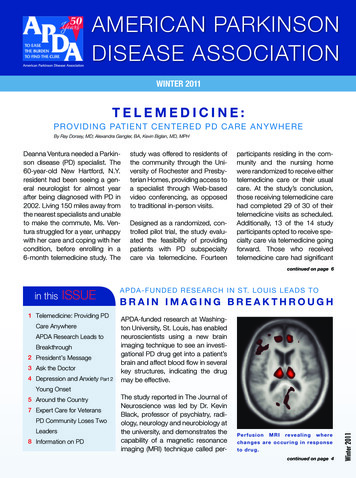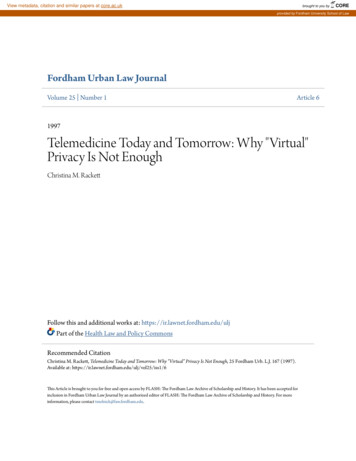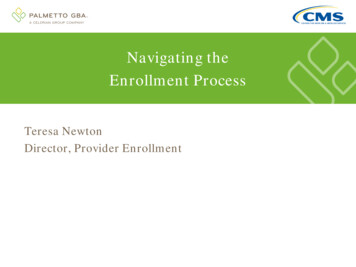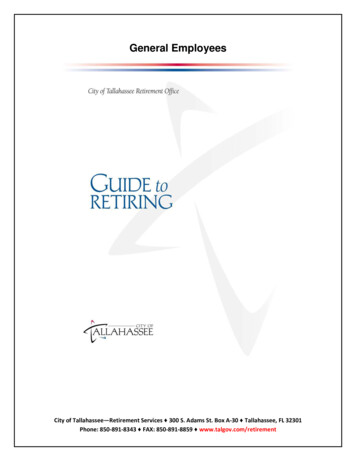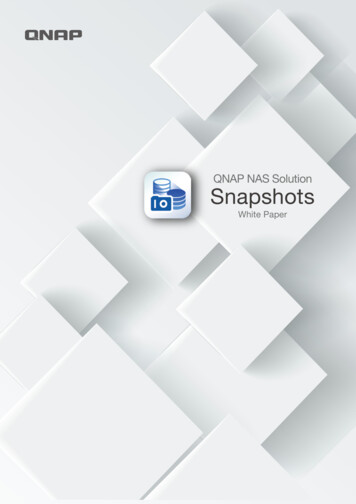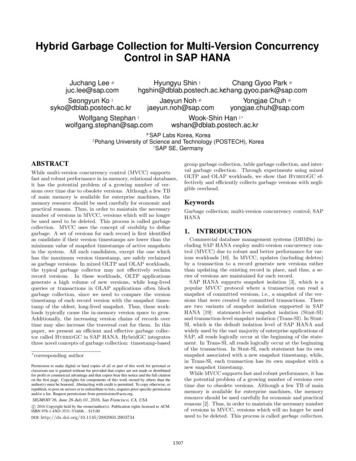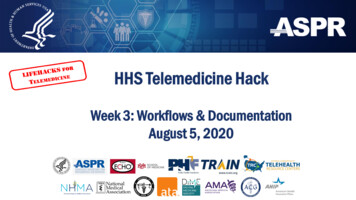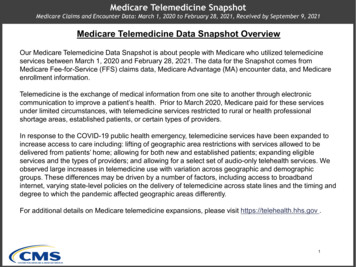
Transcription
Medicare Telemedicine SnapshotMedicare Claims and Encounter Data: March 1, 2020 to February 28, 2021, Received by September 9, 2021Medicare Telemedicine Data Snapshot OverviewOur Medicare Telemedicine Data Snapshot is about people with Medicare who utilized telemedicineservices between March 1, 2020 and February 28, 2021. The data for the Snapshot comes fromMedicare Fee-for-Service (FFS) claims data, Medicare Advantage (MA) encounter data, and Medicareenrollment information.Telemedicine is the exchange of medical information from one site to another through electroniccommunication to improve a patient’s health. Prior to March 2020, Medicare paid for these servicesunder limited circumstances, with telemedicine services restricted to rural or health professionalshortage areas, established patients, or certain types of providers.In response to the COVID-19 public health emergency, telemedicine services have been expanded toincrease access to care including: lifting of geographic area restrictions with services allowed to bedelivered from patients’ home; allowing for both new and established patients; expanding eligibleservices and the types of providers; and allowing for a select set of audio-only telehealth services. Weobserved large increases in telemedicine use with variation across geographic and demographicgroups. These differences may be driven by a number of factors, including access to broadbandinternet, varying state-level policies on the delivery of telemedicine across state lines and the timing anddegree to which the pandemic affected geographic areas differently.For additional details on Medicare telemedicine expansions, please visit https://telehealth.hhs.gov .1
Medicare Telemedicine SnapshotMedicare Claims and Encounter Data: March 1, 2020 to February 28, 2021, Received by September 9, 2021KKey Terms: Types of TelemedicineThere are three main types of telemedicine services that are summarized in this snapshot: Medicare telehealth visits(including audio-only telehealth), virtual check-ins, and e-visits (See the methodology for more detailed specifications).Telehealth Visits: Routine office visits provided via video (requires synchronous, real-time audio and/or video communication)with new or established patients. In this snapshot, we group audio-only telehealth in this service category.Virtual Check-ins: Short patient-initiated communications with a healthcare practitioner via telephone or othertelecommunications device to decide whether an office visit or other service is needed.E-visits: Non-face-to-face patient-initiated communications with a healthcare practitioner through an online patient portal.Key Terms: Medicare UtilizationTelemedicine Users: Number of unique Medicare beneficiaries who received at least one telemedicine service (defined as Evisit, Virtual Check-in, or telehealth, including audio-only telehealth).Telemedicine Eligible Users: Number of unique beneficiaries who received telemedicine eligible services (via Telemedicineor non-telemedicine). We define telemedicine eligible as any E-Visit, virtual check-in, or telehealth eligible code identified fromthe CMS list of covered telehealth services, effective August 2021.Percentage of Medicare Users with a Telemedicine Service: Telemedicine Users divided by Telemedicine Eligible Users2
Medicare Telemedicine SnapshotMedicare Claims and Encounter Data: March 1, 2020 to February 28, 2021, Received by September 9, 2021Key Terms: Beneficiary CharacteristicsMedicare Entitlement: Medicare entitlement is available to three basic groups of "insured individuals" - the Aged, theDisabled, and those with end stage renal disease (ESRD). Medicare entitlement can change over time for beneficiaries thatwere initially entitled to Medicare because of disability or ESRD before the age of 65. For purposes of this reporting,beneficiaries who at any time during the snapshot time period had ESRD, were Aged with ESRD or were Disabled with ESRDare classified as ESRD; otherwise beneficiaries are classified as Disabled or Aged.Medicaid Eligibility Status: A beneficiary can be eligible for Medicare and/or Medicaid. Beneficiaries dually enrolled in bothMedicare and Medicaid at any time during the snapshot time period are considered Dual Medicare and Medicaid enrollees. Abeneficiary enrolled in Medicare alone is Medicare Only. Please note that for beneficiaries enrolled in both Medicare andMedicaid, only claims and encounters covered by Medicare are included in this reporting.Race/ Ethnicity: In the snapshot, a beneficiary’s race/ethnicity is created by taking the beneficiary race code that hashistorically been used by the Social Security Administration (and is in turn used in CMS’s enrollment database) and applyingan algorithm that improves the race/ethnicity classification, particularly for those who are Hispanic or Asian/PacificIslander. This algorithm, developed by the Research Triangle Institute (RTI) and is thus often referred to as the “RTI racecode”, uses Census surname lists for Hispanic and Asian/Pacific Islander origin as well as geography. The race/ethnicityclassifications are: American Indian/Alaska Native (AI/AN), White, Black/African American, Asian/Pacific Islander,Hispanic, and Other/Unknown. For more information on the RTI race algorithm, 95038/.Rural/ Urban: Rural/Urban status is defined using the beneficiary’s mailing ZIP code and the Rural Urban Commuting AreaCrosswalk (RUCA). The RUCA crosswalk relies on commuting data from the US Census, as well as ZIP Codes to defineRural and Urban locations.For additional details on our methodology and data limitations, please see the disclaimer on the next page and view the methodologydocument available here.Please note that this snapshot includes a subset of the data that is available in the accompanying data file; for example, a usercan analyze telemedicine trends by state, month, and race using the data file.3
Medicare Telemedicine SnapshotMedicare Claims and Encounter Data: March 1, 2020 to February 28, 2021, Received by September 9, 2021What You Should Know When Using Our Data (Disclaimer)You should use caution when interpreting our data. We collect Medicare claims and encounter data for payment and other program purposes, butnot for public health surveillance. There will always be a delay or “claims lag” between when a service occurs and when the claim or encounter forthat service is in our database. The length of the lag depends on the service type and program. There may also be longer claims lag due to thepandemic, but we’re not sure of the impact.Historically, 90% of FFS claims across all claim types are submitted within 3 months, while 90% of MA encounters across all claim types aresubmitted within 12 months. We expect timely FFS claims submissions because providers submit claims directly to us for payment. A longerclaims lag is expected for Medicare Advantage encounters because Medicare Advantage Organizations: (1) collect encounters before submittingthem to us and (2) have more time to submit encounters because there are different programmatic uses for the data, like risk adjustment.Percent of Medicare FFS Claims Received by Time after Date of ServiceClaim TypeInpatientSNFHospiceHome HealthOutpatientCarrierDME1 Month†43%2%3%22%37%43%57%2 Months91%81%81%74%90%87%84%3 Months96%94%92%90%95%93%90%6 Months99%98%98%97%98%98%96%9 Months99%99%99%99%99%99%98%12 Months100%100%100%100%100%100%100%Percent of Medicare Advantage Claims Received by Time after Date of ServiceClaim TypeInpatientSNFHome HealthOutpatientProfessionalDME1 Month11%5%11%17%21%23%2 Months52%46%52%63%62%61%3 Months61%66%65%73%73%72%6 Months80%81%83%87%87%86%9 Months88%87%89%92%93%91%12 Months92%92%93%95%95%94%Month 1 is the service month (i.e., month for the claim through date); FFS claims analysis based on data for July 2016; MA encounter data shows the % of encountersreported to us by 30 day increments from the through date of the service for January 2018. The data in this table is meant to be descriptive, but shouldn’t be used to adjustdata presented in this update due to pandemic-related claims submission uncertainties.4
Medicare Telemedicine SnapshotMedicare Claims and Encounter Data: March 1, 2019 to February 28, 2021, Received by September 9, 2021Telemedicine Users: Pre-Pandemic and Pandemic PeriodTotalTelehealthE-visit1Virtual 878367,4671,601,033Pre-pandemic (March 1, 2019 - Feb 29, 2020)Pandemic (March 1, 2020 - Feb 28, 2021)Two Year Trend - Telehealth15,000,00010,000,0005,000,0000Two Year Trend – E-Visits and Virtual Check-Ins800,000600,000400,000200,0000E-Visit UsersVirtual Check-In UsersDisclaimer: All data presented in this update are preliminary and will continue to change as CMS processes additional claims andencounters for the reporting period. Please see page 4 and view the methodology document available here.1Medicarecoverage for E-Visits started on January 1, 2020.5
Medicare Telemedicine SnapshotMedicare Claims and Encounter Data: March 1, 2020 to February 28, 2021, Received by September 9, 202128,255,180 Unique Telemedicine Users53%of Medicare UsersPercentage of Medicare Users with a TelemedicineService¹ by GeographyRural Areas:44%Urban Areas:55%Map Scale: Percentage (%)27394047485455606171Disclaimer: All data presented in this update are preliminary and will continue to change as CMS processes additional claims andencounters for the reporting period. Please see page 4 and view the methodology document available here.¹Only beneficiaries with at least one telemedicine-eligible service are included in the denominator.6
Medicare Telemedicine SnapshotMedicare Claims and Encounter Data: March 1, 2020 to February 28, 2021, Received by September 9, 202128,255,180 Unique Telemedicine Users53%of Medicare UsersPercentage of Medicare Users with a Telemedicine Service¹by Beneficiary Characteristics62%50%Medicare Only51%Aged55%50%Dual Medicare /UnkWhite67%ESRDFemale63%50%53%53%Less than 6565-7475-8485 and overNote: AI/AN American Indian/Alaska NativeDisclaimer: All data presented in this update are preliminary and will continue to change as CMS processes additional claims andencounters for the reporting period. Please see page 4 and view the methodology document available here.¹Only beneficiaries with at least one telemedicine-eligible service are included in the denominator.7
Medicare Telemedicine SnapshotMedicare Claims and Encounter Data: March 1, 2020 to February 28, 2021, Received by September 9, 202128,255,180 Unique Telemedicine Users53%of Medicare UsersPercentage of Medicare Users with a Telemedicine Service¹by Beneficiary Characteristics-Medicare Only vs. Dual Medicare and Medicaid ale61%White60%66%Less than 6559%48%Male48%61%65-7452%61%75-8452%85 and overNote: AI/AN American Indian/Alaska NativeDisclaimer: All data presented in this update are preliminary and will continue to change as CMS processes additional claims andencounters for the reporting period. Please see page 4 and view the methodology document available here.¹Only beneficiaries with at least one telemedicine-eligible service are included in the denominator.58%8
Medicare Telemedicine SnapshotMedicare Claims and Encounter Data: March 1, 2020 to February 28, 2021, Received by September 9, 202128,255,180 Unique Telemedicine Users53%of Medicare UsersPercentage of Medicare Users with a Telemedicine Service¹by Beneficiary Characteristics- By Race/Ethnicity -AI/AN62%65%62%70%63%Asian/Pacific Islander56%Less than 6556%56%54%54%61%Black/African %51%75-8465%Aged62%70%63%White61%56%64%51%85 and over69%69%Disabled64%71%69%ESRDNote: AI/AN American Indian/Alaska NativeDisclaimer: All data presented in this update are preliminary and will continue to change as CMS processes additional claims andencounters for the reporting period. Please see page 4 and view the methodology document available here.¹Only beneficiaries with at least one telemedicine-eligible service are included in the denominator.9
Medicare Telemedicine SnapshotMedicare Claims and Encounter Data: March 1, 2020 to February 28, 2021, Received by September 9, 202128,255,180 Unique Telemedicine Users53%of Medicare UsersPercentage of Medicare Users with a Telemedicine Service¹by Beneficiary Characteristics- By Race/Ethnicity -AI/AN61%58%Asian/Pacific Islander60%66%Black/African %49%Male60%49%Medicare Only61%63%61%69%61%Medicare & MedicaidNote: AI/AN American Indian/Alaska NativeDisclaimer: All data presented in this update are preliminary and will continue to change as CMS processes additional claims andencounters for the reporting period. Please see page 4 and view the methodology document available here.¹Only beneficiaries with at least one telemedicine-eligible service are included in the denominator.10
Medicare Telemedicine SnapshotMedicare Claims and Encounter Data: March 1, 2020 to February 28, 2021, Received by September 9, 2021Medicare Telemedicine Snapshot Data FileA Medicare Telemedicine Snapshot data file is available at the following dicine-snapshot-data-file.zipThe data file includes all data points from the preceding charts. The data file also includes additional levels of detail,presenting Medicare Telemedicine utilization by: Month and StateMonth, State and Medicaid Eligibility StatusMonth, State and Race/EthnicityMonth, State and Medicare StatusMonth, State and Beneficiary SexMonth, State and Age GroupMonth, State and Rural/Urban StatusMonth, Medicaid Eligibility Status and Race/EthnicityMonth, Medicaid Eligibility Status and Medicare StatusMonth, Medicaid Eligibility Status and Beneficiary SexMonth, Medicaid Eligibility Status and Age GroupMonth, Medicaid Eligibility Status and Rural/Urban StatusMonth, Race/Ethnicity and Medicare StatusMonth, Race/Ethnicity and Beneficiary SexMonth, Race/Ethnicity and Age GroupMonth, Race/Ethnicity and Rural/Urban StatusPlease see the methodology document for more details.11
Medicare Telemedicine Snapshot. Medicare Claims and Encounter Data: March 1, 2020 to February 28, 2021, Received by September 9, 2021. Medicare Telemedicine Data SnapshotOverview. Our Medicare Telemedicine Data Snapshot is about people with Medicare who utilized telemedicine services between March 1, 2020 and February 28, 2021.

